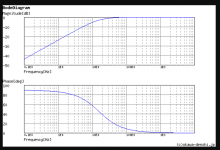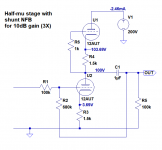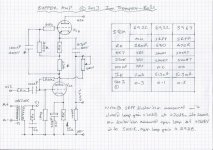Hello all. I have a bunch of old vacuum tubes and I was wondering if there are any circuits that use simple tubes (preferably AA5 tubes like 12BA6, 12BE6, etc) as a sort of buffer to add tube-like timbres and tones to an input audio signal. I am not an expert when it comes to working with tubes (I generally try to avoid it when possible) so any help is appreciated. Thanks
I've been reading around a bit as I wanted to add a cathode follower buffer on the output of a phonostage. I found that in general, most comments end up suggesting that adding a buffer is a poor second place to a better design that doesn't need one. However, sometimes we are stuck with what we have, and a buffer might just be needed.
Anyway, in my case, I built the one from The Valve Wizard -Cathode Follower and it seems to work very well. Doesn't use the tubes you mention in your list though, and in reading around a bit, the 12au7 is the one recommended more often than any others.
Anyway, in my case, I built the one from The Valve Wizard -Cathode Follower and it seems to work very well. Doesn't use the tubes you mention in your list though, and in reading around a bit, the 12au7 is the one recommended more often than any others.
12AU7 has a 7.7Kohm RP. 12BH7A at 5.4K should you want a lower Rp vs Load impedance. Both are mu=17.
The output capacitor value depends on the load. If the load is say 10k,
you'll need around a 10uF electrolytic capacitor, unless there's room for
a physically large film type instead.
you'll need around a 10uF electrolytic capacitor, unless there's room for
a physically large film type instead.
If the load is 10k a 1uF cap will have corner at 15hz.The output capacitor value depends on the load. If the load is say 10k,
you'll need around a 10uF electrolytic capacitor, unless there's room for
a physically large film type instead.
A too large cap will increase leakage and might give problems at turn on/off
OTOH, one could argue that "tube-like timbres and tones" is not something added, but rather something _not_ added by playback electronics. Opinions will vary.
All good fortune,
Chris
All good fortune,
Chris
A cathode follower is not a good way to add tube timbre because it has 100% negative feedback which acts to reduce distortion by the mu of the tube. Probably better to use a topology that by its very nature produces more distortion. Something like an SRPP would do. However, once again you cannot tame its gain with NFB because that will reduce the amount of tone so you need to use it open loop and place an attenuator at the output. The 12AU7 is an excellent tube for producing tube tone because it has a very high intrinsic distortion.
Cheers
Ian
Cheers
Ian
If the load is 10k a 1uF cap will have corner at 15hz.
A too large cap will increase leakage and might give problems at turn on/off
Still too much roll off for me though. I use 10uF in most cases. That way even a 1k load will have 15Hz -3 point 🙂
I find these to be great caps, too. KYET | KYET MKP20106J2EAC461625 | Polypropylene Film Capacitors (CBB) - LCSC.COM
Attachments
Last edited:
as a sort of buffer to add tube-like timbres and tones to an input audio signal.
Since a buffer has no gain, it adds very little "timbers and tones" or harmonic distortions. If your sole purpose is to add some flavoring, you're better off with a single gain stage with no feedback for some seasoning of the sound.
I found that in general, most comments end up suggesting that adding a buffer is a poor second place to a better design that doesn't need one. However, sometimes we are stuck with what we have, and a buffer might just be needed.
I agree with you and I am a fan of buffers. I am not a fan of using muscular tube acting as gain stage AND driver/buffer in order to use just one tube. The reluctance of purists to use buffer stage resulted in using obscure mutant tubes and driving their prices up. I prefer cheap and common tubes. In a line stage I much prefer a simple tube stage coupled to a buffer so it can drive various loads. There's nothing wrong with buffers and forget the purists!
A cathode follower is not a good way to add tube timbre because it has 100% negative feedback which acts to reduce distortion by the mu of the tube. Probably better to use a topology that by its very nature produces more distortion. Something like an SRPP would do. However, once again you cannot tame its gain with NFB because that will reduce the amount of tone so you need to use it open loop and place an attenuator at the output. The 12AU7 is an excellent tube for producing tube tone because it has a very high intrinsic distortion.
I completely agree with you.
There's an anti-12AU7 crowd that's completely barking the wrong tree!
12AU7 has fairly low gain (mu of about 12 to 15 at most normal operating points).
Because of its fairly low gain, it wouldn't take much negative feedback to reduce stage gain to maybe 2 to 5. How about using a 12AU7 in a good old "anode follower" circuit? It's kind of a buffer with gain, because the feedback reduces the output impedance. Since it uses shunt feedback, input impedance is also reduced compared to a standard common cathode stage. The series resistor in the network defines the input impedance, so you could use a 47k to 150k resistor there.
Since you want to add 'tube flavor' to the sound, you don't want to make the circuit as distortionless as possible. Maybe use a low B+ and a little feedback to get the gain down to about 4X? Would that be too much?
Another possibility is the 'half-mu' stage, which is an SRPP with the output taken from the bottom tube's plate, instead of the top tube's cathode. You get half the mu, but the output impedance might be rather high.
What happens if you reduce gain by using a half-mu stage, and wrap shunt NFB around it to knock the gain down to 3X (10dB)?
I whipped up a simulation and it seems it performs at a perfectly mediocre performance level into a 100k ohm load. At 1V rms output (300mV in) THD = 0.07%, all second harmonic.
Into a 10k ohm load (such as the input of a typical class D amplifier), gain drops to about 1.82X, so it will now take 550mV signal at the input to get to 1V output. THD at 1V output is now 0.28%, H2 at -51dB, H3 at -86dB. That should give you that 'tube sound'. 😀
Kidding aside, choice of tube type and operating conditions could give you the performance you want for your particular application. An anode follower with a high mu triode like 12AT7 can be made to have very low distortion performance into something like a 47k ohm load. For heavier loads a 6DJ8 or 6N6P run at higher Ip would yield better drive.
--
PS:
If you want something like this that uses a triode with gain of only about 2.5X but is still within the realm of 'high fidelity' driving a 10k ohm load, I think a 6N6P with 300V B+, 15k Rplate, red LED in the cathode, and shunt NFB to bring the gain down to 2.5X will be just dirty enough to give some tube sound (1V rms out at 0.04% THD into a 10k ohm load).
Just for fun. This is not an exemplar of best practices. Just for fun.
Because of its fairly low gain, it wouldn't take much negative feedback to reduce stage gain to maybe 2 to 5. How about using a 12AU7 in a good old "anode follower" circuit? It's kind of a buffer with gain, because the feedback reduces the output impedance. Since it uses shunt feedback, input impedance is also reduced compared to a standard common cathode stage. The series resistor in the network defines the input impedance, so you could use a 47k to 150k resistor there.
Since you want to add 'tube flavor' to the sound, you don't want to make the circuit as distortionless as possible. Maybe use a low B+ and a little feedback to get the gain down to about 4X? Would that be too much?
Another possibility is the 'half-mu' stage, which is an SRPP with the output taken from the bottom tube's plate, instead of the top tube's cathode. You get half the mu, but the output impedance might be rather high.
What happens if you reduce gain by using a half-mu stage, and wrap shunt NFB around it to knock the gain down to 3X (10dB)?
I whipped up a simulation and it seems it performs at a perfectly mediocre performance level into a 100k ohm load. At 1V rms output (300mV in) THD = 0.07%, all second harmonic.
Into a 10k ohm load (such as the input of a typical class D amplifier), gain drops to about 1.82X, so it will now take 550mV signal at the input to get to 1V output. THD at 1V output is now 0.28%, H2 at -51dB, H3 at -86dB. That should give you that 'tube sound'. 😀
Kidding aside, choice of tube type and operating conditions could give you the performance you want for your particular application. An anode follower with a high mu triode like 12AT7 can be made to have very low distortion performance into something like a 47k ohm load. For heavier loads a 6DJ8 or 6N6P run at higher Ip would yield better drive.
--
PS:
If you want something like this that uses a triode with gain of only about 2.5X but is still within the realm of 'high fidelity' driving a 10k ohm load, I think a 6N6P with 300V B+, 15k Rplate, red LED in the cathode, and shunt NFB to bring the gain down to 2.5X will be just dirty enough to give some tube sound (1V rms out at 0.04% THD into a 10k ohm load).
Just for fun. This is not an exemplar of best practices. Just for fun.
Attachments
Last edited:
And of course ruffrecords was right that an SRPP is going to be a goo choice in this particular situation.
Here's the circuit above, but with the output moved from the lower triode's plate (a half-mu stage) to the upper triode's cathode (a 'quasi-SRPP').
Even into a heavy 10k ohm load, the quasi-SRPP with shunt feedback performs pretty well. Gain is about 2.7X, THD with 1V rms out into a 10k ohm load is predicted to be about 0.05%, H2 30dB higher than H3. That's not too terrible, for a tube-tone effects box for recorded music listening. For what it's worth...
Here's the circuit above, but with the output moved from the lower triode's plate (a half-mu stage) to the upper triode's cathode (a 'quasi-SRPP').
Even into a heavy 10k ohm load, the quasi-SRPP with shunt feedback performs pretty well. Gain is about 2.7X, THD with 1V rms out into a 10k ohm load is predicted to be about 0.05%, H2 30dB higher than H3. That's not too terrible, for a tube-tone effects box for recorded music listening. For what it's worth...
Attachments
You only need to look at op-amps. The CF design of the first tube op amps disappeared in favour of push-pull topologies in silicon.
Here is a buffer amp I designed many years ago for use in pro audio mixers. It uses a 6922 (6DJ8). Notice that the mu follower version needs about twice the quiescent current to drive a similar load as the SRPP because the SRPP is push pull whereas the mu follower is single ended. Distortion was measured a pro audio levels. For hi fi use at 2V rms they will be much lower.
Cheers
Ian
Cheers
Ian
Attachments
I built this one. Love it!
Muchedumbre Buffer Preamp – wauwatosa tube factory
That one is very like the valve wizard one posted above - and allows for a different B+ - can I ask what anode voltage do you end up with using the EZ81 and choke?
B+ voltage
The load line is below so the tube is operating at 150VDC and 10mA.
The circuit has a 15K cathode resistor so 15K x 10mA = 150VDC
so 150V+150V=300VDC. So the plate would have 300VDC as B+.
If you are picky, add in the 3V bias and you have 303VDC on paper.


what anode voltage do you end up with using the EZ81 and choke?
The load line is below so the tube is operating at 150VDC and 10mA.
The circuit has a 15K cathode resistor so 15K x 10mA = 150VDC
so 150V+150V=300VDC. So the plate would have 300VDC as B+.
If you are picky, add in the 3V bias and you have 303VDC on paper.


If the goal is to inject some 'tube sound' into the system, a well designed cathode follower/buffer probably won't do it. It will be very clean, low THD, transparent. In other words, as long as it's properly designed and built, you won't even know it's there.
I used solid state and not tubes like EZ81, a choke and some resistors for drop the B+, and the 15K resistor will get hot. Use minimum 5W resistors.That one is very like the valve wizard one posted above - and allows for a different B+ - can I ask what anode voltage do you end up with using the EZ81 and choke?
Last edited:
- Home
- Amplifiers
- Tubes / Valves
- Any designs for a simple tube-based buffer circuit?



